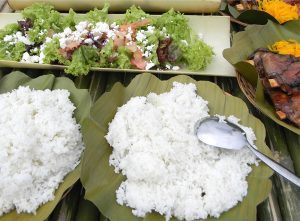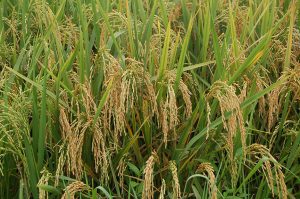Every night, an average Filipino joins at least 3.7 billion other people who go to sleep still hungry. Their hunger, however, is not the growling, aching kind that most people experience when they have not eaten a meal. Rather, the hunger is somewhat silent and insidiously stunting their bodies and brains, weakening their immune systems, and sapping their energy. The prospects for living productive lives is questionable.
This hidden hunger – as most nutritionists called it – is called malnutrition and it contributes to killing an estimated 40,000 people every day!
“We’re still losing one generation after another to malnutrition and this just shouldn’t be happening anymore,” deplored Dr. Howard Bouis, a senior research fellow at the Washington-based International Food Policy Research Institute.
In the thickly-populated Asia, where nearly all the world’s rice is grown and eaten, food means rice. In the Philippines, for instance, rice is the staple food of Filipinos. A study research conducted by Southeast Asian Regional Center (SEARCA) commissioned by the Philippine Rice Research Institute (PRRI) said that Filipinos eat an average of 119 kilograms of rice annually.
The study was conducted in 2009 to 2010. Another research found that Filipinos consume about 4-5 cups of cooked rice per day. “If we did not have rice, our deepest comfort food, we would probably feel less Filipino,” said the late food epicure Doreen Fernandez.
Although rice is basically a complex carbohydrate, its protein contains all eight of the essential amino acids found in many other foods. Low in sodium and fat, with no cholesterol or gluten, it is a boon to weight worriers and those allergic in other grains. It is also low in fiber and easily digested. Eating one-half cup of cooked rice can furnish 82 calories of energy — enough to give person energy to walk 26 minutes.
 Since rice is consumed in great amounts, the cereal is a good vehicle for solving the malnutrition problem. And this can be done by food fortification.
Since rice is consumed in great amounts, the cereal is a good vehicle for solving the malnutrition problem. And this can be done by food fortification.
According to the Food and Nutrition Research Institute (FNRI), food fortification is “the addition of one or more essential nutrients to a food, whether or not it is normally contained in the food, for the purpose of preventing or correcting a demonstrated deficiency in one or more nutrients in the population of specific population groups in which a risk of nutrient deficiency has been identified.”
One of the nutrients identified as lacking in Filipino diet is iron. “Iron is one of the most important minerals in the body,” a press release issued by the Department of Science and Technology (DOST) explained.
According to the Academy of Nutrition and Dietetics, the significant function of iron is to carry oxygen in the hemoglobin or red blood cells throughout the body so cells can produce energy. Thus, it enhances body strength, activates brain performance, and boosts body resistance against sickness. Iron also helps eliminate carbon dioxide from the body.
However, the recommended level of iron in the body is classified by gender and age. Males aging from 14 to 18 are recommended with 11 milligrams, and aged 19 and above must have 8 milligrams daily intake. The daily intakes for females aged 14 to 18, 19 to 50, and 51 and above must have 15 milligrams, 18 milligrams, and 8 milligrams, respectively. This indicates that females need more iron than males.
A person who does not get enough iron from his diet will have a lower hemoglobin level. “If this condition is prolonged, one will be suffering from iron deficiency anemia or IDA,” warns FNRI, a line agency of DOST.
IDA develops when body stores of iron drop too low to support normal red blood cell production. “In the Philippines, IDA is very serious across population groups,” FNRI says, adding it is most common among newly-born babies (from 6-11 months old) and pregnant women.
Among children, the consequences of IDA include poor scholastic performance due to poor cognition, low attention span, and frequent attacks of illness due to lowered immune response.
 Low and poor productivity due to easy fatigability are what adults experience when they have IDA. Pregnant women with IDA, on the other hand, may suffer from stillbirths, miscarriages and hemorrhage, or worst, death of the baby.
Low and poor productivity due to easy fatigability are what adults experience when they have IDA. Pregnant women with IDA, on the other hand, may suffer from stillbirths, miscarriages and hemorrhage, or worst, death of the baby.
In a recent National Nutrition Survey, it was found that the Philippines has national iron-deficiency prevalence rate of 11%. Another nutritional survey suggested that about 50% of the iron intake, even among high-income households, comes from the cereals, particularly rice and corn.
Balancing cereal-based diets with vegetables and animal products is one approach used in some developing countries to address malnutrition problems. But results were frustrating. Vegetables and animal products are expensive, and seasonal, subject to spoilage because of limited storage and transport facilities.
In 2000, the government signed the Food Fortification Law or Republic Act No. 8976. It stipulates mandatory fortification of staples like rice with iron and voluntary fortification of processed foods with iron, vitamin A and/or iodine.
In 2004, the National Food Authority (NFA) fortified rice with iron. “NFA led the implementation of the law and has imported iron premix rice (IPR) fortified with ferrous sulfate using coating technology from the United States as no locally produced IPR was available at that time,” said a briefing paper on iron-fortified rice (IFR).
The IFR was distributed to already “identified nutritionally-at-risk areas” through Food for Schools Program. Unfortunately, the NFA fortified rice was less accepted by consumers due to the dark yellow-colored iron premix in rice and the darkening color of cooked rice. In 2010, NFA stopped the importation of IPR and is now committed to utilizing locally-produced IPR.
For its part, FNRI developed IPR made from rice flour blended with iron – with micronized dispersible ferric pyrophosphate as fortificant – using extrusion technology, which proved to be stable for one-year storage with iron content still retained.
The National Center for Biotechnology Information said ferric pyrophosphate is “a water-insoluble iron compound used to fortify infant cereals and chocolate drink powders.”
In a study conducted among school children in a public school in Pasig, it was found that there was “a very significant decline in anemia prevalence from 100% to 33%.” The IFR was rated as “liked moderately” to “liked very much.”
The ancient Indian name for rice, dhanya, meaning “sustainer of the human race,” indicates its age-old importance. In Java, where it is the gift of the goddess Dewi Siri, people believe that rice has a soul and may be spoken to as a relative.
An old Chinese relief for aching bones, stomach upsets and colds was toasted brown rice and minced ginger root simmered in wine, tied in cloth and rubbed on the joints, stomach or chest.
“Grain upon grain, fresh and delightful as frost, a dazzling jewel, to what can I compare this treasure,” wrote Chinese poet Yang Ji.






